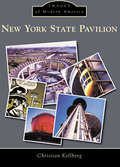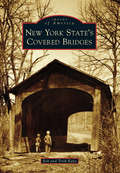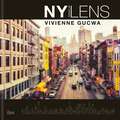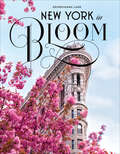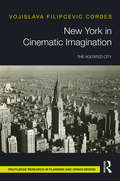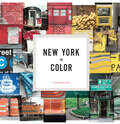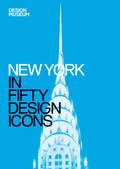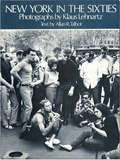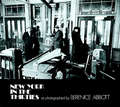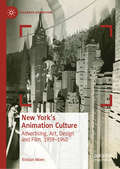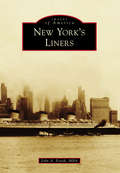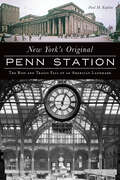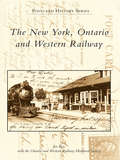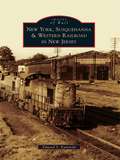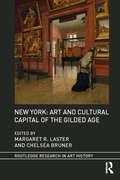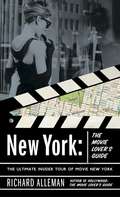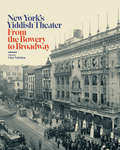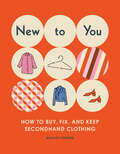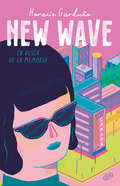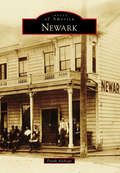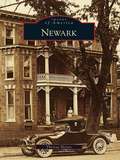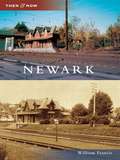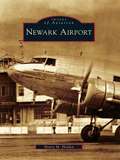- Table View
- List View
New York State Pavilion
by Christian KellbergThe New York State Pavilion is a legacy of the 1964-1965 New York World's Fair. It is located in the southwest corner of Flushing Meadow Corona Park, where the Long Island Expressway crosses over the Grand Central Parkway. From these freeways alone, the pavilion is seen by hundreds of thousands of motorists per day and is a symbol of the Empire State, the "Eiffel Tower of Queens." From the observation towers that offer spectacular views of Queens and beyond; to the expansive Tent of Tomorrow, which showcased the world's largest map (of New York State); to the stunning Queens Theatre in the Park, New York State Pavilion is an insightful look at this iconic landmark, with many spectacular historic color photographs, published here for the first time.
New York State's Covered Bridges
by Trish Kane Bob KaneAt one time, New York State had over 300 covered bridges, but over the years, floods, fires, and modernization have claimed all but 32 of them. Both the Hyde Hall Covered Bridge and the Old Blenheim Bridge are proud record holders. Located in Glimmerglass State Park, the Hyde Hall Covered Bridge is the oldest existing covered bridge in the United States. The Old Blenheim Bridge was the longest single-span covered bridge in the world until it was washed away by Tropical Storm Irene in 2011 when the Schoharie Creek flooded. Today, Oxford, New York, is home to the Theodore Burr Covered Bridge Resource Center, which was specifically designed for covered bridge researchers--the first-ever center of its kind.
New York Through the Lens
by Vivienne GucwaStreet photographers will never tire of New York as a subject. It is the perfect setting for the genre, the world's most evocative cityscape, against which candid, memorable moments play themselves out every day. Nearly a decade ago, Vivienne Gucwa began walking the streets of the city with the only camera she could afford a sub-$100 point-and-shoot and started taking pictures. Choosing a direction and going as far as her feet would take her, she noticed lines, forms and structures that had previously gone unnoticed but which resonated, embodying a sense of home. Having limited equipment forced her to learn about light, composition and colour, and her burgeoning talent won her blog millions of readers and wide recognition in the photographic community. New York Through the Lens showcases the stunning results of her ongoing quest. Filled with spectacular photographs and illuminated by Vivienne's own insightful commentary, NY Through the Lens acts as a beautiful travel guide to the city; it will be a must-read for her many fans and for any lover of street photography.
New York Through the Lens
by Vivienne GucwaStreet photographers will never tire of New York as a subject. It is the perfect setting for the genre, the world's most evocative cityscape, against which candid, memorable moments play themselves out every day. Nearly a decade ago, Vivienne Gucwa began walking the streets of the city with the only camera she could afford a sub-$100 point-and-shoot and started taking pictures. Choosing a direction and going as far as her feet would take her, she noticed lines, forms and structures that had previously gone unnoticed but which resonated, embodying a sense of home. Having limited equipment forced her to learn about light, composition and colour, and her burgeoning talent won her blog millions of readers and wide recognition in the photographic community. New York Through the Lens showcases the stunning results of her ongoing quest. Filled with spectacular photographs and illuminated by Vivienne's own insightful commentary, NY Through the Lens acts as a beautiful travel guide to the city; it will be a must-read for her many fans and for any lover of street photography.
New York in Bloom
by Georgianna LaneA floral tour of the metropolis, filled with sumptuous photography: &“A magical and unexpected look at New York . . . lovely and brilliant.&” —Laura Dowling, former chief floral designer at the White House From stylish floral studios and corner shops overflowing with fresh-cut blooms, through bustling flower markets, to blooming trees and lush public parks, an unexpected softer side of New York is revealed in photos juxtaposing floral beauty with exquisite botanical details found in the city&’s iconic architecture. Author and photographer Georgianna Lane adds to her acclaimed works Paris in Bloom and London in Bloom with this collection including: Parks and gardens Floral studios Market flowers Floral displays Field guides to locating and identifying common spring blooms A list of recommended locations and vendors A tutorial on how to create your own New York–style floral bouquet, and more &“A bountiful and effervescent garden that brilliantly dots the landscape of the city that never sleeps.&” —Robert Wheeler, author of Hemingway&’s Paris
New York in Cinematic Imagination: The Agitated City
by Vojislava Filipcevic CordesNew York in Cinematic Imagination is an interdisciplinary study into urbanism and cinematic representations of the American metropolis in the twentieth century. It contextualizes spatial transformations and discourse about New York during the Great Depression and the Second World War, examining both imaginary narratives and documentary images of the city in film. The book argues that alternating endorsements and critiques of the 1920s machine age city are replaced in films of the 1930s and 1940s by a new critical theory of "agitated urban modernity" articulated against the backdrop of turbulent economic and social settings and the initial practices of urban renewal in the post-war period. Written for postgraduates and researchers in the fields of film, history and urban studies, with 40 black and white illustrations to work alongside the text, this book is an engaging study into cinematic representations of New York City.
New York in Color
by Nichole Robertson&“Organizes the city in an array of beautiful and cohesive shades . . . One of the best books about New York City by way of vibrant and striking images.&” —New York Simply This photographic portrait of New York captures the city as never before, in a vibrant visual tour, color by color. From Staten Island Ferry orange to taxicab yellow, photographer and writer Nichole Robertson brings New York&’s quintessential shades into focus, seeking out the city&’s hiding-in-plain-sight treasures: bananas sold streetside for a dollar, bright red &“no parking&” signs, stacks of delicious golden-brown pretzels, gleaming Art Deco gold archways. Arranged by color, these striking views portray the spirit of the city across every borough. A unique love letter to the iconic metropolis, this celebration of the city will charm locals as well as everyone who loves—or dreams of—visiting the Big Apple. Praise for Nichole Robertson&’s Paris in Love &“A beautiful ode that will leave you pining for Paris.&” —Lindsey Tramuta, author of The New Paris &“That magic feeling you get when you are falling in love with a person or place—in this case Paris!—is encapsulated in this stunning gem of a book.&” —Samantha Hahn, author of Well-Read Women &“We&’re smitten by Nichole Robertson&’s Paris in Love, which celebrates all things Parisian—especially crimson things, from raspberry tarts to scarlet mopeds, rosy begonias and glossy, berry-hued cafe chairs—in glorious photographs.&” —San Jose Mercury News
New York in Fifty Design Icons: Design Museum Fifty
by Design Museum Enterprise Limited Julie IovineIn this new series, the Design Museum looks at the fifty design icons of major cities around the world - icons that, when viewed together, inherently sum up the spirit of their city. Covering anything from buildings and monuments to a graffiti mural or an item of clothing, we are able to build up an intricate portrait of a city, layer by layer. From the infamous Chysler Building and the Brooklyn Bridge to the New York Yankees logo or CBGB's, the beating heart of the 1970s punk movement, New York is a tapestry of design masterpieces. Join Julie Iovine, architectural writer at the Wall Street Journal and formerly of the New York Times, as she unravels the visual history of one of our most famous and fascinating cities.Contents include:Empire State BuildingFlat Iron BuildingTiffany & Co. powder blueCBGBsRadio City Music HallStonewall, Christopher StreetStock Exchange bellMillionaire's Row, Fifth AvenueGuggenheim MuseumNew York Yankees logo...and many more.
New York in the Sixties
by Allan R. Talbot Klaus LehnartzCompelling photographs offer a vivid and varied tableau of daily life: shoppers, subways, Central Park, Coney Island, dozens of other revealing views of the city. 159 photographs by Lehnartz.
New York in the Thirties (New York City)
by Berenice AbbottNearly 100 classic images by noted photographer: Rockefeller Center on the rise, Bowery restaurants, dramatic views of the City's bridges, Washington Square, old movie houses, rows of old tenements laced with laundry, Wall Street, Flatiron Building, waterfront, and many other landmarks.
New York's Animation Culture: Advertising, Art, Design and Film, 1939–1940 (Palgrave Animation)
by Kristian MoenThis book reveals and explores the thriving animation culture in midtown Manhattan, the World’s Fair, art galleries and cinemas during a vibrant period of artistic, commercial and industrial activity in New York City. Alongside a detailed investigation of animated film at the time – ranging from the abstract works of Mary Ellen Bute and Norman McLaren to the exhibition practices of the Disney Studios and the New York World’s Fair – New York’s Animation Culture examines a host of other animated forms, including moving dioramas, illuminated billboards, industrial displays, gallery exhibitions, mobile murals, and shop windows. In this innovative microhistory of animation, Moen combines the study of art, culture, design and film to offer a fine-grained account of an especially lively animation culture that was seen as creating new media, expanding the cinema experience, giving expression to utopian dreams of modernity, and presenting dynamic visions of a kinetic future.
New York's Golden Age of Bridges
by Antonio Masi Joan Marans DimIn New York’s Golden Age of Bridges, artist Antonio Masi teams up with writer and New York City historianJoan Marans Dim to offer a multidimensional exploration of New York City’s nine major bridges, their artistic andcultural underpinnings, and their impact worldwide.The tale of New York City’s bridges begins in 1883, when the Brooklyn Bridge rose majestically over the East River, signaling the start of America’s “Golden Age” of bridge building. The Williamsburg followed in 1903, the Queensboro (renamed the Ed Koch Queensboro Bridge) and the Manhattan in 1909, the George Washington in 1931, the Triborough (renamed the Robert F. Kennedy Bridge) in 1936, the Bronx-Whitestone in 1939, the Throgs Neck in 1961, and the Verrazano-Narrows in 1964. Each of these classic bridges has its own story, and the book’s paintings show the majesty and artistry, while the essays fill in the fascinating details ofits social, cultural, economic, political, and environmental history.America’s great bridges, built almost entirely by immigrant engineers, architects, and laborers, have come to symbolize not only labor and ingenuity but also bravery and sacrifice. The building of each bridge took a human toll. The Brooklyn Bridge’s designer and chief engineer, John A. Roebling, himself died in the service of bridge building. But beyond those stories is another narrative—one that encompasses the dreams and ambitions of a city, and eventually a nation. At this moment in Asia and Europe many modern, largescale, long-span suspension bridges are being built. They are the progeny of New York City’s Golden Age bridges. This book comes along at the perfect moment to place these great public projects into their historical and artistic contexts and to inform and delight artists, engineers, historians, architects, and city planners. In addition to the historical and artistic perspectives, New York’s Golden Age of Bridges explores the inestimable connections that bridges foster, and reveals the extraordinary impact of the nine Golden Age bridges on the city, the nation, and the world.
New York's Liners
by John A. FostikFor 175 years, passenger ships have crossed the Atlantic, linking the Old World with the New World. Between 1892 and 1954, more than 12 million immigrants passed through the port of New York. National rivalries caused ships to grow in size, speed, and a comfort that had once been unimaginable. The advent of the passenger jet in 1958 changed how people travel. New York's harbor is now quieter, and there are no longer days with six liners ready to sail to fabled European ports. Happily, one can still sail to Europe, cruise the Caribbean, or take a world cruise from Manhattan aboard a new generation of liners like the Queen Mary 2. New York's Liners captures iconic images of the great ships from the 1890s to the present day.
New York's Original Penn Station: The Rise and Tragic Fall of an American Landmark (Landmarks)
by Paul M KaplanThe story of the spectacular and much-lamented train terminal whose destruction inspired a new passion for historic preservation. Includes photos. In early twentieth-century New York, few could have imagined a train terminal as grand as Pennsylvania Station. Yet, executives at the Pennsylvania Railroad secretly bought up land in Manhattan's infamous Tenderloin District to build one of the world's most spectacular monuments. Sandhogs would battle the fiercest of nature to build tunnels linking Manhattan to New Jersey and Long Island. For decades, Penn Station was a center of elegance and pride. But the ensuing rise of the airplane and automobile began to diminish train travel. Consequently, in the mid-1960s, the station was tragically destroyed. The loss inspired the birth of preservation laws in the city and the nation that would save other landmarks—such as New York&’s Grand Central, just blocks away. Here, Paul Kaplan recounts the trials and triumphs of New York's Penn Station, with extensive photos and illustrations.
New York, Ontario and Western Railway, The
by Joe Bux Ontario and Western Railway Historical SocietyThe New York, Ontario and Western Railway was the first class-one railroad in the United States to be abandoned in its entirety. Whereas other rail lines were closed gradually, the federal government closed down the railroad on March 29, 1957, for its failure to pay employee withholding taxes. The railroad went into bankruptcy in 1937 after its main shipping commodity, coal, was rapidly replaced by oil for home heat. As time passed, the interest in this abandoned railroad grew, and much of the company's records have been recovered and preserved. Today, with 750 members, the Ontario and Western Railway Historical Society Archives Center houses this unique corporate record collection. In addition, there are extensive private collections of everything from locomotives, passenger cars, lanterns, and tools to company passes and railroad police memorabilia.
New York, Susquehanna & Western Railroad in New Jersey
by Edward S. KaminskiOriginally incorporated in 1881, the New York, Susquehanna & Western Railroad has had a long history in New Jersey. The railroad expanded by the early 1890s into the thriving Pennsylvania coalfields and eventually grew to over 200 miles of trackage in the northern portion of New Jersey. Always viewed as an underdog in a marketplace surrounded by much larger railroads, the New York, Susquehanna & Western emerged from 40 years of Erie Railroad control; survived several bankruptcies, reorganizations, abandonments, and retrenchments through innovative passenger and freight service offerings; and transformed into today's regional rail carrier with a size far greater than ever imagined.
New York: Art and Cultural Capital of the Gilded Age (Routledge Research in Art History)
by Margaret R. Laster Chelsea BrunerFueled by a flourishing capitalist economy, undergirded by advancements in architectural design and urban infrastructure, and patronized by growing bourgeois and elite classes, New York’s built environment was dramatically transformed in the 1870s and 1880s. This book argues that this constituted the formative period of New York’s modernization and cosmopolitanism—the product of a vital self-consciousness and a deliberate intent on the part of its elite citizenry to create a world-class cultural metropolis reflecting the city’s economic and political preeminence. The interdisciplinary essays in this book examine New York’s late nineteenth-century evolution not simply as a question of its physical layout but also in terms of its radically new social composition, comprising the individuals, institutions, and organizations that played determining roles in the city’s cultural ascendancy.
New York: The Movie Lover's Guide
by Richard AllemanThe classic guide to who-did-what-where in New York, on- and off-screen, including: Classic film and TV locations: Marilyn Monroe's infamous Seven Year Itch subway grating . . . the deli where Meg Ryan famously faked an orgasm in When Harry Met Sally . . . the diner where Courteney Cox (in Friends) and Kirsten Dunst (in Spider-Man) waitressed . . . Men in Black's Manhattan headquarters . . . The Godfather mansion on Staten Island...the Greenwich Village apartment where Jack Nicholson terrorized Greg Kinnear in As Good as It Gets . . . Ghostbusters' Tribeca firehouse . . . Michael Douglas and Gwyneth Paltrow's A Perfect Murder palazzo . . . the landmark West Side building that housed Tom Cruise in Vanilla Sky and Mia Farrow in Rosemary's Baby . . . the Greenwich Village apartment of Friends . . . Will & Grace's Upper West Side building . . . The All in the Family block in Queens . . . The Sopranos' New Jersey mansion (and the real Bada Bing club) . . . Seinfeld's favorite diner . . . Sex and the City's sexiest haunts . . . and many more . . . Stars' childhood homes: Lena Horne's Bedford-Stuyvesant townhouse . . . Frank Sinatra's Hoboken row house . . . Barbra Streisand's Flatbush housing project . . . J.Lo's Bronx block . . . Humphrey Bogart's Upper West Side tenement . . . the Marx Brothers' Upper East Side brownstone . . . Apartments and townhouses of the silver screen's greatest legends: Joan Crawford . . . Marlene Dietrich . . . James Dean . . . Katharine Hepburn . . . Montgomery Clift . . . Rita Hayworth . . . Rock Hudson . . . and . . . Plus: Superstar cemeteries . . . major film and TV studios . . . historic movie palaces and Broadway theaters . . . star-studded restaurants and legendary hotels . . . For movie-loving New Yorkers, travelers and armchair film buffs, New York: The Movie Lover's Guide is the ultimate insider's guide to the Big Apple's reel attractions.
New York’s Yiddish Theater: From the Bowery to Broadway
by Edna NahshonIn the early decades of the twentieth century, a vibrant theatrical culture took shape on New York City's Lower East Side. Original dramas, comedies, musicals, and vaudeville, along with sophisticated productions of Shakespeare, Ibsen, and Chekhov, were innovatively staged for crowds that rivaled the audiences on Broadway. Though these productions were in Yiddish and catered to Eastern European, Jewish audiences (the largest immigrant group in the city at the time), their artistic innovations, energetic style, and engagement with politics and the world around them came to influence all facets of the American stage. Vividly illustrated and with essays from leading historians and critics, this book recounts the heyday of "Yiddish Broadway" and its vital contribution to American Jewish life and crossover to the broader American culture. These performances grappled with Jewish nationalism, labor relations, women's rights, religious observance, acculturation, and assimilation. They reflected a range of genres, from tear-jerkers to experimental theater. The artists who came of age in this world include Stella Adler, Eddie Cantor, Jerry Lewis, Sophie Tucker, Mel Brooks, and Joan Rivers. The story of New York's Yiddish theater is a tale of creativity and legacy and of immigrants who, in the process of becoming Americans, had an enormous impact on the country's cultural and artistic development.
New to You: How to Buy, Fix, and Keep Secondhand Clothing
by Melody FortierSick of cheap, wasteful, disposable fast fashion? Learn how to shop for vintage clothing and accessories and build a more sustainable, stylish closet. In this indispensable guide, anyone who buys or wears women&’s clothing will learn how to:• Avoid overpaying• Sort trash from treasure• Fix minor flaws—and spot major ones• Find your ideal silhouette (including tips for plus-size shoppers)• Alter and repurpose garments• Care for delicate vintage fabricsBuying older clothing means getting beautiful pieces that are built to last, without contributing to sweatshops or landfills—but only if you know what to look for. Let a vintage clothing expert guide you to ethical fashion bliss!Previously published as The Little Guide to Vintage Shopping in 2009, this updated edition includes a new introduction and resources for evaluating online and brick-and-mortar shops.
New wave. En busca de la memoria
by Horacio GarduñoTres chicos, un mal recuerdo perdido en el limbo y una banda post punk. Lucrecia canta en una banda punk y se expresa con intensidad inusual, con una energía brutal en el escenario, y vaya que tiene un mundo interior por manifestarse, pues su vida en casa no ha sido fácil. La música es su vía de desfogue. En su mente hay otra Lucrecia, más inocente, que ha olvidado su pasado a causa de una experiencia traumática. Pero cuando conoce a Juan José, un baterista que se deja llevar por el trance de la música, las cosas empiezan a reacomodarse de forma extraña. Lucre busca recuperar sus memorias y las escribe en una libreta. Pero aún debe ahondar en ciertos recuerdos, los más dolorosos. Un día llegan dos personas al hoyo funky donde debuta su banda, una del pasado de Lucre y otra de su futuro, ambas la harán entrar en un dilema que la enfrentará con aquello que tanto teme. Explora los viajes y las subrealidades de la mente humana en el tiempo y en el espacio. Una nueva ola de la vida a pesar de los goles recibidos.
Newark
by Frank AddiegoOften overlooked as a minor enclave surrounded by the sprawling suburb of Fremont and confused with its New Jersey namesake, Newark, California, has been a hub of innovation commercially, industrially, and technologically, even before it officially became a city in 1955. While Newark had already been home to factories and chemical plants, citizens were reticent to allow the small town to become an industrial section of the city and thus opted out of an ambitious plan among several hamlets to become Fremont. Since then, it has become a functioning city unto its own with its own infrastructure and a passionate constituency whose spirit has made Newark a friendly city but never a boring one.
Newark
by Theresa HesseyDuring the past 250 years, Newark has transformedfrom a tiny farming community into a thriving small city. Its history includes the arrival of a variety of industries--including paper, woolen, and fibre mills and an automobile manufacturing plant--that have expanded the city's commercial and economic opportunities. Newark has also been home to the University of Delaware from its beginnings as a small academy in 1767. As a result, Newark's history is interwoven with that of the university. Althoughmany of the industries that once thrived in Newark have closed because of technological advances and shifting economies, the city continues to grow. Main Street is now the retail hub of the city, and stores reside in what were private residences. Despite all of the changes brought on by industry and the passage of time, Newark has maintained its small-town feel.
Newark
by William FrancisNew Ark, as it is pronounced and appeared on colonial maps, is located in New Castle County near the borders of Pennsylvania and Maryland. Scotch-Irish and Welsh settlers developed Newark as a market town around the intersection of two Lenni Lenape trails. Newark remained little more than a village throughout its history, reaching a population of only 11,000 by 1960. Today it is over 30,000, with an additional 15,000 students at the University of Delaware.
Newark Airport (Images of Aviation)
by Henry M. HoldenNewark Airport was the first major airport in the New York metropolitan area. It opened on October 1, 1928, occupying an area of filled-in marshland. In 1935, Amelia Earhart dedicated the Newark Airport Administration Building, which was North America's first commercial airline terminal. Newark was the busiest airport in the world until LaGuardia Airport, in New York, opened in 1939. During World War II, Newark was closed to passenger traffic and controlled by the United States Army Air Force for logistics operations. The Port Authority of New York took over the airport in 1948 and made major investments in airport infrastructure. It expanded, opened new runways and hangars, and improved the airport's terminal layout. The art deco administration building served as the main terminal until the opening of the North Terminal in 1953. The administration building was added to the National Register of Historic Places in 1979.
